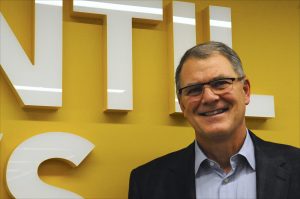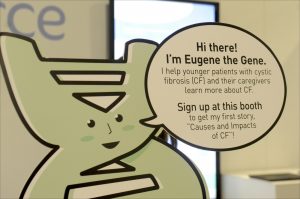CFF’s Preston Campbell: 2019 is a ‘Pivotal Year’ for CF Therapies
Written by |

Preston Campbell, CEO of the Cystic Fibrosis Foundation, at CFF headquarters in Bethesda, Maryland.
A baby born with cystic fibrosis (CF) today can now expect to live a median 44 years, says Preston W. Campbell, MD, president and CEO of the Cystic Fibrosis Foundation (CFF).
“Life expectancy for CF patients is going up every year, and I think it’ll reach 70 or 80 in time,” Campbell recently told Cystic Fibrosis News Today. This, he said, “reflects advances in care that have drastically increased both life expectancy and quality of life for people with CF.”
Campbell spoke from CFF’s headquarters in Bethesda, Maryland. The slogan “Until it’s done” — which greets all visitors to CFF as they step off the 12th-floor elevator — is a not-so-subtle reminder that the nonprofit group has a long way to go until therapies are available for every one of the estimated 30,000 Americans with CF.
Campbell, who became interested in the disease 25 years ago as a CF camp counselor while attending the University of Virginia Medical School, sees 2019 as “a pivotal year” for CF patients. The keynote speaker at last November’s 32nd Annual North American Cystic Fibrosis Conference (NACFC 2018) in Denver, Colorado, he likes to call progress in treating CF “the most amazing story in medicine today.”
At the moment, he said, roughly 65 percent of U.S. patients have an approved therapy for their genetic cause of CF — and that more than 90 percent of them may eventually benefit from the triple combination therapies in development by Vertex Pharmaceuticals.
The Cystic Fibrosis News Today forums are a place to connect with other patients, share tips and talk about the latest research. Join today!
In February 2018, the U.S. Food and Drug Administration (FDA) approved Symdeko (tezacaftor/ivacaftor and ivacaftor) to treat CF patients age 12 and older carrying two copies of the F508del mutation in the CFTR gene (the gene defective in CF), or with one mutation that responds to tezacaftor/ivacaftor.
High hopes for triple-combo drugs
Vertex’s two other blockbuster CF therapies are Kalydeco (ivacaftor) — the first drug to address the underlying cause of CF rather than treat its symptoms — and Orkambi (ivacaftor/lumacaftor), which was approved by the FDA in 2012.
“Those with two F508del mutations will have significantly better CFTR restoration. Many individuals who are not on a modulator now will have access to highly effective treatments for the very first time,” Campbell said. “This was unimaginable not only in 1955 (when CFF was established), but also just 10 years ago.”
Of note, F508del is the most common mutation of the more than 1,700 known CFTR mutations.
Between 5 and 10 percent of people with CF have mutations that will never respond to modulator therapy alone, he said.
“Our hope for the triple combination is that everyone with at least one F508del mutation will have a Kalydeco-like effect,” Campbell said.
Of note, when Kalydeco was developed, it yielded results that surpassed all best hopes, including significant benefits in the lung function of CF patients.
“But even if that happens, that’s not where we want to end, because we want 100 percent of people to have these transformative therapies that address basic defects,” Campbell said.
Several years ago, he noted, “we realized that we needed to know which of those mutations may benefit from these modulators. So we started creating cells in the lab in order to evaluate them.”
Getting to 100% won’t be easy
The organization Campbell heads employs 700 people, nearly 400 of them at its Bethesda office. The CFF launched its own patient registry in 1966, and in 2017 spent $248.7 million on medical research and care, as well as other educational and support services for CF patients and their families, caregivers and clinicians.
“Venture philanthropy was needed to move therapies forward, but it wouldn’t have worked had we not set up a care center network,” Campbell said. “Patients needed to be old enough to participate in clinical trials; that care center network enabled that to happen. Then you needed the science. In the 1980s, we really accelerated our research initiative by funding 11 research development programs. We had only $400,000 in the bank, but we committed $10 million to that.”
In 2017, the CFF funded more than 200 research awards, in areas ranging from infection to inflammation, and last year undertook a record 68 clinical trials. The foundation has committed $72 million to its multi-year Nonsense and Rare Mutations Research and Therapeutics Initiative, and at NACFC 2018 announced a new five-year, $100 million Infection Research Initiative.
“We believe that 3 percent of CF patients not currently on modulators have rare mutations could potentially respond,” Campbell said. “The remaining 7 percent, including those whose genetic mutation will not result in any CF protein, will need another approach. Getting to 100 percent is going to take some time, but I’m very confident we’ll get there.”
To that end, the CFF is working on a range of research projects aimed at addressing nonsense mutations, including two efforts focused on small-molecule drugs called readthrough compounds. Southern Research, a nonprofit institute based in Birmingham, Alabama, is actively screening 750,000 compounds. And last year, the CFF announced it would award Arizona-based Icagen up to $11 million to screen two million compounds. These small-molecule therapies could be used to treat CFTR systematically in every organ of the body, he said.
According to its annual report, the CFF invested $7.3 million in finding a cure for all CF patients, with 40 percent of that going to gene editing, 40 percent to adult stem cells, and 20 percent to gene delivery. And the organization’s CF pipeline currently has more than 25 drug candidates in development.
Transplant ‘a personal decision’
“We have to get those with unfixable genetic mutations. We do that by replacing a normal copy of genetic material, either messenger RNA or DNA. Gene therapy has been revitalized. We’ve learned a lot in the last 20 years,” Campbell said, adding that the organization funded 15 projects for gene editing and gene delivery in 2017 alone.
He added: “What we’re doing now is building consortia and scientific efforts around the world. We’re developing the animal models that’ll be required to move this forward. It’s a promising approach, but it’s going to take some time.”
Asked about lung transplant, Campbell described it as “exchanging one disease for another,” but noted the CFF’s $23.5 million commitment to a multi-year Lung Transplant Initiative that began in 2016. The program hopes to significantly increase survival rates for people undergoing transplants, in part by establishing best practices and developing new therapies that will enable those with lung transplants to better fight organ rejection.
“Getting a transplant is a very personal decision that people must make for themselves,” Campbell said. “We want to make sure we’ve removed all barriers so it’s a better option for everybody going forward.”
A complete cure for CF is still years away, Campbell said. But progress is moving faster than anyone could have imagined.
“Even with patients living to 80 years of age, we still won’t be done,” he said. “Our dream is that one day people can say, ‘I used to have CF.’ This will be possible because of advances in gene editing. At that time — and only at that time — will we be done.”










